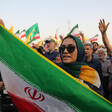Rights and Accountability 9 July 2015
An Israeli colonel shot dead a Palestinian teenager last Friday, apparently as he ran away, investigations by two human rights organizations have concluded.

Muhammad al-Kasbeh
Defense for Children International PalestineMuhammad Sami Ali al-Kasbeh, a 17-year-old resident of Qalandiya refugee camp, was killed near Qalandiya checkpoint in the occupied West Bank at about 6:30 am that morning.
According to Defence for Children International–Palestine (DCI-Palestine), Muhammad was among a group of Palestinians who were prevented by Israeli forces from entering occupied Jerusalem to join Ramadan prayers at the city’s al-Aqsa mosque.
A short time later, an Israeli military vehicle passed through the area and Muhammad threw a stone at it and ran away, human rights group Al-Haq reports in its own investigation.
Two Israeli soldiers then stepped out of the vehicle, one, Colonel Yisrael Shomer, opening fire on Muhammad. Muhammad was hit by at least three bullets in the back, face and upper side of his torso.
Israel has claimed that the shooting was justified because the soldiers’ lives were in “danger.”
But Al-Haq says the evidence indicates that the gunman “arbitrarily shot and killed Muhammad, who posed no threat to the Israeli soldiers’ lives at the time of the shooting.”
There were no confrontations or demonstrations taking place in the vicinity at the time, eyewitnesses told Al-Haq.
Intent to kill
The fact that Muhammad was shot in the upper part of his body from a distance of about 20 meters indicates “an intent to kill,” Al-Haq adds. It says that the gunman “approached Muhammad’s body after he had fallen on the ground, looked at it, and then returned to the military vehicle without providing any assistance.”
“The multiple gunshots that struck the teen in the face and upper part of his body at close distance suggest the military commander had fired to kill rather than subdue him,” DCI-Palestine’s accountability program director Ayed Abu Eqtaish stated, adding that the killing showed “a complete disregard for human life.”
Al-Haq also challenges Israeli claims that the Israeli soldiers issued a verbal warning and fired warning shots and says the Israeli timeline of the incident is not credible.
“One eyewitness stated that a single bullet was fired in the air, however no other witnesses corroborated the Israeli claim that a verbal warning was issued,” Al-Haq states.
“Muhammad’s death was a shock for my wife and me,” Muhammad’s father Sami told DCI-Palestine. “My wife is still in denial and I am trying my best to support her, but I feel helpless.”
Muhammad was the third boy in his family to be killed by Israeli occupation forces. His two older brothers Yasser and Samer, then aged respectively 11 and 15, died fewer than 40 days apart during the second intifada.
Israeli provocation
DCI-Palestine notes that the presence of Israeli soldiers at many heavily militarized Israeli checkpoints throughout the occupied West Bank, including East Jerusalem, “creates tension and leads to clashes between civilians and the military.”
In April, occupation forces shot dead 17-year-old Ali Abu Ghannam at a checkpoint in Jerusalem’s al-Tur neighborhood.
In that case, as in virtually every other case, the perpetrators of these killings enjoy complete legal impunity as well as broad endorsement for their actions within Israeli society.
Silent killers
Separately, Israeli human rights group B’Tselem condemned in June Israel’s continued use of live ammunition to kill and injure unarmed Palestinians.
The group says it “has documented dozens of cases in the Ramallah area of the West Bank in which Palestinians were injured, some severely, by live ammunition fired by Israeli security forces.”
The shootings often occurred during demonstrations.
The group says that “the large number of persons injured and the types of injury, indicates that live ammunition was used against demonstrators even when security forces were not in mortal danger.”
B’Tselem states that some of the rifles occupation forces use to fire so-called “Two Two,” or .22 caliber, bullets are fitted with sound suppressors.
“Therefore, when a sniper aims a rifle at demonstrators and a person then sustains a live-bullet injury although no gunshot was heard, it is clear the ammunition was Two-Two bullets.”
In March, an Israeli sniper killed 20-year-old Ali Mahmoud Abd al-Rahman Safi in the West Bank’s Jalazone refugee camp using this type of bullet, B’Tselem states.
The frequency of such shootings, B’Tselem adds, shows that it is “not a matter of exceptional incidents but rather the implementation of an unlawful policy.”
Last month, The Electronic Intifada’s Charlotte Silver reported from Gaza that Israeli occupation forces shot across the boundary fence at four boys out for an evening stroll. Two were hit in the legs and one was critically injured.
One of the boys, Muhammad Sami Abu Reda, 17, said he never heard the gunshots, but just saw his friends suddenly fall to the ground.
This may be an indication that the same type of bullets Israel is shooting at Palestinians in the West Bank are also being used during Israel’s near-daily ceasefire violations in Gaza.





Comments
Ah yes, the old tried & true "soldiers’ lives in danger" reason.
Permalink Zionism Is Not Judaism replied on
An explanation worthy of the jailhouse prisoner, found tied face down in bed, with a bullet in the back of the head, while attempting to escape. Go with it!